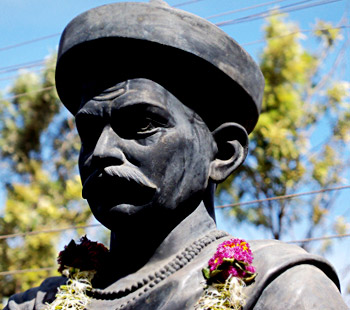Dadoji Konddeo was Shivaji`s tutor and guardian. He was a 16th century martial arts expert from India who was an extremely loyal servant of his master Shahaji. Konddeo was also a Subehdar of Kondada fort. Dadaji Kondeo came from a Marathi Brahmin family and in his early life; he functioned as a nobleman and a commander in the Nizamshahi military of Ahmednagar. When Shahaji set up his own military base near the Pune region, he appointed Dadoji Konddeo as the instructor, who was particularly skilled in warfare and swordsmanship. Since Shahaji was constantly engaged in diplomatic maneuvers due to the constant warfare between the three forces, he sent Dadoji Konddeo along with council of ministers to look after his wife Jijabai and son Shivaji and to look after the jagir as well from1637 till his death 1649 at the age of 72. Thus Dadoji Konddeo looked after the administration of the small jagir of Shahaji, while Shahaji himself was in Bangalore as the commander of Adilshah.
 Dadoji Konddeo is credited with the overall supervision of Shivaji`s later education. By the time Konddeo was given the charge of Shivaji, the boy had already completed eight years of age. He was already tutored in Sanskrit Language and war tactics by his own father. Dadoji Konddeo took care of Maharaj`s education from 1636 to 1646. From a young age the tutor was aware of the boy`s fierce streak of independence. Shivaji had great respect for him. Repeatedly he told Dadoji Konddeo that he wanted to learn wisdom from him, but when Konddeo`s way of thinking brought Shivaji back on the beaten track, the young man sidetracked the wisdom which was being drummed into him. Of the two, Shivaji was the more practical.
Dadoji Konddeo is credited with the overall supervision of Shivaji`s later education. By the time Konddeo was given the charge of Shivaji, the boy had already completed eight years of age. He was already tutored in Sanskrit Language and war tactics by his own father. Dadoji Konddeo took care of Maharaj`s education from 1636 to 1646. From a young age the tutor was aware of the boy`s fierce streak of independence. Shivaji had great respect for him. Repeatedly he told Dadoji Konddeo that he wanted to learn wisdom from him, but when Konddeo`s way of thinking brought Shivaji back on the beaten track, the young man sidetracked the wisdom which was being drummed into him. Of the two, Shivaji was the more practical.
Dadaji Konddeo was concerned about Shivaji`s decision to establish an independent kingdom. He advised him to follow the footsteps of his ancestors, who rose to the positions of power and wealth as vassals of the Deccan Sultanates. Shivaji`s association with the hill brigands and his plans of capturing forts worried Dadaji a lot. He complained to Shahaji, but this didn`t change Shivaji`s plans. Dadaji Konddeo died in 1647, leaving Shivaji in control of the region at the age of 17.



















